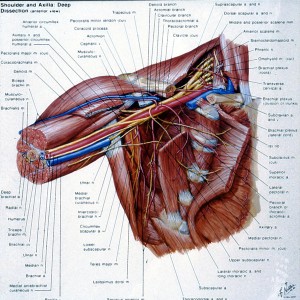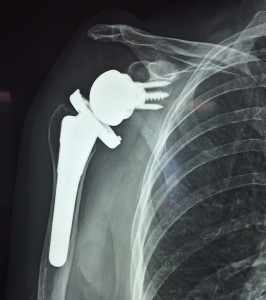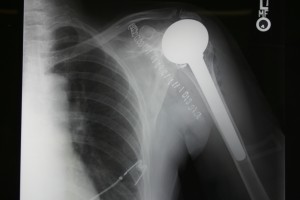Total Shoulder Replacement is becoming a much more common surgery than it was a few years ago. New implant designs, surgical techniques, and biomaterials are leading to better results. The shoulder joint is a very complex joint, controlled by many muscles. It is inherently unstable, and that is what gives it such a remarkable range of motion. The shoulder is very much more dependent on soft tissues than other joints like the knee and hip.  The shoulder joint is likened to be similar to a golf ball sitting sideways on a golf tee. The shoulder socket, also called the glenoid, is analogous to the golf tee. The glenoid is dish shaped and very shallow, and this is the reason the shoulder is the most common joint in the body to dislocate. So it is very important to have a strong rotator cuff, the muscles that move, balance, and support the shoulder. Unfortunately, it is very common to see degeneration and tears of the rotator cuff associated with severe shoulder arthritis. If there is a large or unrepairable cuff tear, then a Reverse Shoulder Replacement may be a better option for your shoulder. The reverse shoulder is a more difficult operation and has more activity restrictions. The implants are more constrained, and therefore may be more prone to damage during heavy lifting or sports.
The shoulder joint is likened to be similar to a golf ball sitting sideways on a golf tee. The shoulder socket, also called the glenoid, is analogous to the golf tee. The glenoid is dish shaped and very shallow, and this is the reason the shoulder is the most common joint in the body to dislocate. So it is very important to have a strong rotator cuff, the muscles that move, balance, and support the shoulder. Unfortunately, it is very common to see degeneration and tears of the rotator cuff associated with severe shoulder arthritis. If there is a large or unrepairable cuff tear, then a Reverse Shoulder Replacement may be a better option for your shoulder. The reverse shoulder is a more difficult operation and has more activity restrictions. The implants are more constrained, and therefore may be more prone to damage during heavy lifting or sports.

The best indication for shoulder replacement is for the relief of pain. We will do a “hemiarthroplasty” on younger patients who still want to do heavy lifting or sports. The hemiarthroplasty only replaces the metal “ball” of the humerus, and leaves the socket bone in place without a plastic glenoid component. The thin plastic is the most vulnerable to wear and loosening in active younger patients.

If you have shoulder pain and stiffness from arthritis, avascular necrosis, or prior trauma, you should see a qualified and well trained shoulder surgeon and see if shoulder replacement can help you become more functional. Rehabilitation after shoulder replacement is a bit easier than hip and knee replacement surgery, as we let you use the arm immediately for simple tasks (like feeding yourself), and you do not need to walk on your hands after the surgery.